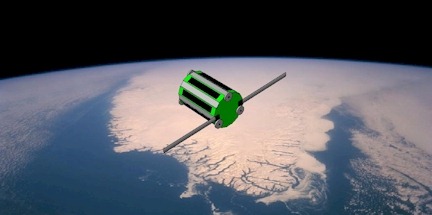Forget personal cell phone towers. Forget even laser guns. If you have the moolah you can now launch your very own satellite. Price: $8000 only. The age of Personal Satellite is here.
Planet Earth’s Interorbital's TubeSat Personal Satellite (PS) Kit is a low-cost alternative to the CubeSat, another private satellite project started in 1999 to help universities, companies and even government organization to perform space science and exploration at fraction of the cost. CubeSats could each be made and launched for an estimated $65,000 – $80,000 dollars, a price tag far lower than most satellite launches. Planet Earth does it for even lower - $8000.

TubeSat has three-quarters of the mass (0.75-kg or 1.65-lb) and volume of a CubeSat, but still offers plenty of room for most experiments or applications. Since the TubeSats are placed into self-decaying orbits 310 kilometers (192 miles) above the Earth's surface, they do not contribute to the long-term build-up of orbital debris. After operating for a few months (the exact length of time on orbit is dependent on solar activity), they will safely re-enter the atmosphere and burn-up.
A TubeSat is designed to function as a Basic Satellite Bus or as a simple stand-alone satellite. Each TubeSat kit includes the satellite's structural components, printed circuit board (PCB) Gerber Files, electronic components, solar cells, batteries, transceiver, antennas, microcomputer, and the required programming tools. With these components alone, the builder can construct a satellite that puts out enough power to be picked up on the ground by a hand-held amateur radio receiver. Simple applications include broadcasting a repeating message from orbit or programming the satellite to function as a private orbital amateur radio relay station. These are just two examples. The TubeSat also allows the builder to add his or her own experiment or function to the basic TubeSat Kit.
Examples of add-on experiments or applications include the following:
- Earth-from-space video imaging
- Earth magnetic field measurement
- Satellite orientation detection (horizon sensor, gyros, accelerometers, etc.)
- Orbital environment measurements (temperature, pressure, radiation, etc.)
- On-orbit hardware and software component testing (microprocessors, etc.)
- Tracking migratory animals from orbit
- Testing satellite stabilization methods
- Biological experiments
- On-orbit advertising
- Private e-mail
- Space art
- Space burials
32 TubeSats can be integrated into and launched by a single NEPTUNE 30 launch vehicle. Once on-orbit, the satellites are released according to a pre-programmed timing sequence. The NEPTUNE 30 TubeSat launches will take place at the IOS Spaceport Tonga, located on the southern tip of the island of 'Eua in the South Pacific Kingdom of Tonga.
Launches are expected to begin in the first quarter of 2011.
[via Makezine]
Other outlandish projects: Open Luna, an open sourced mission to the moon

Comments
Post a Comment